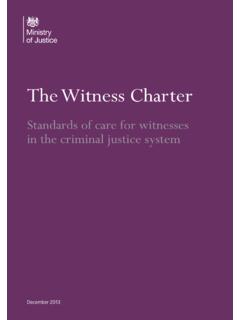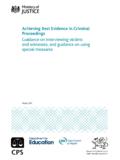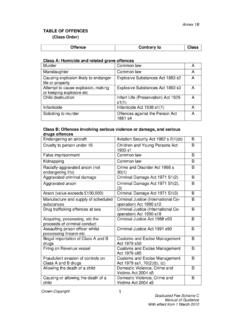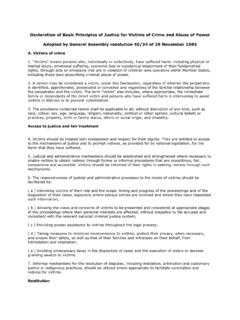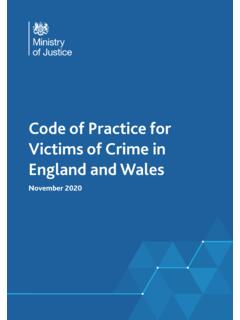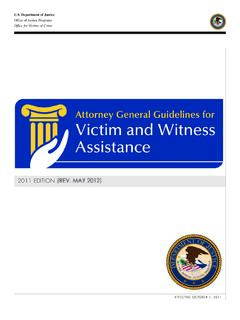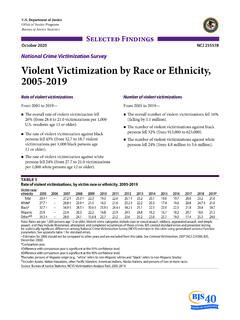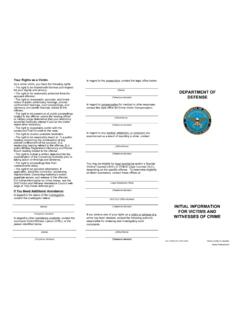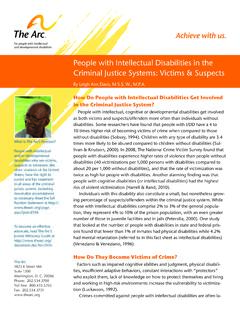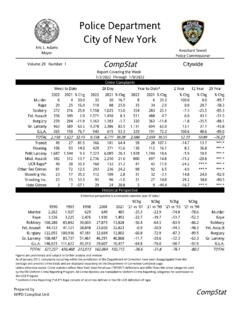Transcription of Hate Crime: What It Is and How to Support Victims and ...
1 1 2 Introduction This guide is about hate crime and how to help those who may be Victims of this kind of offending behaviour. It is designed for people working in voluntary organisations, as well as frontline staff in health, housing or social welfare in fact anyone who might be the first to hear about an incident. It accompanies a guide to hate crime for people who may be Victims or witnesses of such offences. This guide includes information on: Recognising hate crime Recording and reporting hate crime Prosecuting hate crime Supporting Victims and witnesses Some examples of successful prosecutions Recognising hate crime The term hate crime can be used to describe a range of criminal behaviour carried out by one or more perpetrators, such as verbal abuse, intimidation, threats, harassment, assault and bullying, as well as damage to property.
2 It can also include mate crime , where the perpetrator can be a friend, carer or acquaintance, and befriends someone to exploit this friendship for financial gain or some other criminal purpose. The law protects people against discrimination, prejudice and hostility directed towards disability, ethnicity, gender identity, nationality, race, religion or sexual orientation. These are aspects of a person s identity described in the law on equality as protected characteristics . The following definition has been agreed between the Police and the CPS for identifying cases involving hostility based on protected characteristics: Any criminal offence which is perceived by the victim or any other person, to be motivated by hostility or prejudice, based on a person s disability or perceived disability; race or perceived race; or religion or perceived religion; or sexual orientation or perceived sexual orientation or a person who is transgender or perceived to be transgender.
3 The offender may assume something about the victim that is wrong. This doesn t matter, because the hostility is still there, based on the characteristics that the offender has targeted. There is no legal definition of hostility so the CPS uses the everyday understanding of the word which includes ill-will, spite, contempt, prejudice, unfriendliness, antagonism, resentment and dislike. Do you or your client think that hostility might have played any part in the incident(s) complained of? 3 4 Recording and reporting hate crime When an incident is first reported, it will be recorded as a hate crime if the victim or witness or any other relevant person (including, for example, an investigating officer, or CPS lawyer) considers that there was an element of hostility involved. This perception-based test focuses for the most part on the subjective view of the victim.
4 It arises from the Stephen Lawrence Inquiry Report and a perception at the time that the police and others failed to recognise and treat complaints of racist abuse and harassment seriously. Once recorded as a hate crime , the police will look for and identify evidence in Support of this perception. This requires an objective assessment to ascertain whether there is enough evidence to satisfy a court that the suspect demonstrated hostility or was motivated by hostility towards one of the protected characteristics. It is not always possible to bring a hate crime prosecution. This is because: There might not be enough evidence to allow the case to be prosecuted Even where there is enough evidence to prosecute in relation to the crime committed, there might not be enough evidence to show that it was linked to hostility and should be prosecuted as a hate crime .
5 However, it is always important to report a hate incident to the police so that it can be investigated and recorded. This helps to build up a picture of what is going on locally and what can be done to prevent it. Why should a hate crime be reported quickly? Some crimes will have a time limit for prosecution. It is therefore important to report an incident as soon as possible after it has happened so that the police have sufficient time to fully investigate and gather all relevant evidence of hostility. If evidence of hostility is found, it can be presented to the court so that, on conviction, the court can be asked to pass a longer or more severe sentence as a result. This is known as sentence uplift . 5 Prosecuting hate crime The legal framework for hate crime prosecutions is provided by the crime and Disorder Act 1998 and the Criminal Justice Act 2003.
6 These two Acts operate differently but deal with the issue of hostility in a similar way. Both Acts provide for longer and more severe sentences when hostility is present. The crime and Disorder Act 1998 (CDA 1998) contains a number of specific offences of racially and religiously aggravated crime based on the offences of wounding, assault, damage, stalking, harassment and threatening or abusive behaviour. To prove that such offences are racially or religiously aggravated, the prosecution has to prove the basic offence followed by racial or religious aggravation, as defined in section 28 CDA 1998. The Criminal Justice Act 2003 (CJA 2003) gives the court power to enhance the sentence of any offence that is racially or religiously aggravated (section 145) or aggravated by reason of disability, sexual orientation or gender identity (section 146).
7 The relevant provisions within the CJA 2003 and CDA 1998 use the same terminology in setting out aggravation: at the time of committing the offence or immediately before or after doing so, the offender demonstrated towards the victim hostility based on the victim's membership (or presumed membership) of (specified group(s)) or the offence was motivated (wholly or partly) by hostility towards members of a (protected characteristic) based on their membership (or presumed membership) of that (specified groups(s)). How can hostility be proved? Evidence of hostility might include words or actions at the time of the offence, or just before or just after it happened. Words might be abusive towards the personal characteristic or presumed personal characteristic, and action or behaviour might, for example, target something specific to the personal characteristic or presumed personal characteristic, such as a hijab, a yarmulke or a mobility aid.
8 It might be that the offender has done this kind of thing before, or has expressed prejudice towards people who share the personal characteristic in question, either online, with neighbours and friends or with other potential witnesses. It can be helpful to keep a log or a diary of incidents, taking photos of any damage. By examining its casework, the CPS has identified some common features or behaviour that can be seen in hate crime offending, and can help shine a light on the offender s motivation and point to evidence of hostility: 6 there may have been previous incidents of a similar nature opportunistic offences become systematic triggers such as world or domestic incidents involving violence holidays or events associated with religious or cultural activity incidents may escalate in severity and frequency false accusations of the victim being a paedophile or a terrorist sustained attacks and excessive violence cruelty, humiliation and degrading treatment aggressive mocking leading to physical assault stalking and harassment disclosure of prohibited information under the Gender Recognition Act 2004 Gathering all relevant information is very important and is a matter for the police.
9 The Code for Crown Prosecutors The Code for Crown Prosecutors sets out the principles that prosecutors apply when making decisions about prosecutions. A copy can be found on the CPS website at The Code states that prosecutors must be satisfied that: there is a realistic prospect of conviction; and it is in the public interest to prosecute. If the offence was motivated by hostility and there is enough evidence then it is more likely that a prosecution will be in the public interest. The law provides the framework and previous court decisions are influential in helping decide cases. However, every case will depend on its own individual circumstances and there is no guarantee of a successful outcome. Other crime involving hate Stirring up racial and religious hatred and hatred based upon sexual orientation are offences under the Public Order Act 1986 (POA 1986).
10 The offence of stirring up racial hatred under sections 17 to 29 POA 1986 differs in its legal elements from the offences of stirring up religious hatred and hatred based upon sexual orientation under sections 29A to 29N POA 1986. Further information about these offences is available at Stirring up racial hatred is committed when someone says or does something (including posting material online, displaying a poster, performing a play or broadcasting on the media) which is threatening, abusive or insulting, and the person either intends to stir up racial hatred or makes it likely that racial hatred will be stirred up. 7 Stirring up religious hatred or hatred on the grounds of sexual orientation is committed if a person uses threatening words or behaviour or displays any threatening written material (including posting material online, displaying a poster, performing a play or broadcasting on the media), and intends to stir up religious hatred or hatred on the grounds of sexual orientation.


